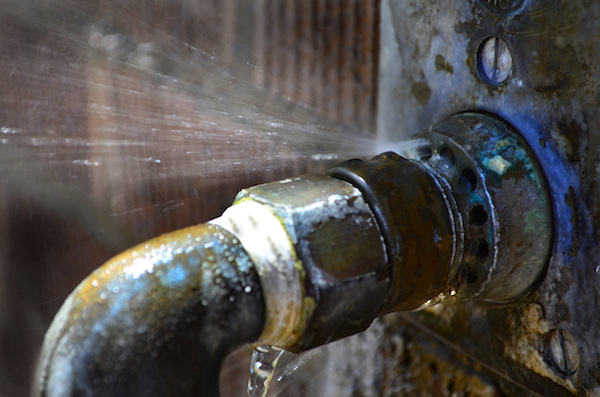As professionals, we know all too well that sometimes there are leaks that you can fix yourself. Stopping leaks at plumbing joints is one of them. Plumbing leaks can become serious if left unnoticed, or left unattended, however, here’s a step by step guide if it appears a call to us isn’t necessary. The best time to fix a plumbing leak is before it happens, by properly connecting water supply and waste line fittings. While this is true, leaks happen.
Have on hand:
- Adjustable wrench
- Slip joint pliers
- Wrench set
- Flexible supply tubes
- Teflon pipe joint compound
- Teflon tape
Wrap the pipe threads with plumbers’ tape counterclockwise. Start by wrapping the male threads with Teflon tape. With the end of the threaded pipe facing you as shown, wrap the plumber’s tape clockwise. Usually three layers is enough. Once in a while, you’ll run into a loose fitting that requires four or five wraps. Stretch and tear the tape to complete the wrap.
Smear a little pipe joint compound on the plumber’s tape. Spread a thin layer of Teflon pipe joint compound over the tape. If you’re working with plastic pipe, choose Teflon pipe joint compound that’s compatible with it. Then start the threads by hand before tightening the connection with wrenches. Wipe away the excess pipe joint compound.
Using two wrenches, tighten the connection over the joint compound and plumbers’ tape.
There’s a reason we recommend using plumbers (Teflon) tape. Connections that rely on threaded pipes and fittings are prone to leaks if they’re not sealed with either Teflon tape or Teflon pipe joint compound. We use both pipe joint compound and Teflon on every joint for extra security.
Lubricate the ferrule (brass ring) with pipe joint compound. Pipe joint compound helps the brass ferrule seal to the valve.
Tighten the compression fitting. The pipe joint compound provides a greater margin of safety. Compression joints are most common on shutoff valves, although you find them on other fittings as well. They have a brass or plastic ring (ferrule) that’s compressed into a recess when you tighten the nut, forming a seal. Lubricating the pipe and the ferrule with a bit of Teflon pipe joint compound helps the ferrule slide along the pipe and squeeze tightly into the recessed fitting with less wrench pressure. Tighten compression fittings firmly with two wrenches to crimp the ferrule onto the pipe. Also make sure the pipe or tube goes straight into the fitting. Misalignment will cause a leak. If the fitting leaks after you turn on the water, try tightening the nut an additional one-quarter turn. This usually stops the leak.
DIY plumbing fixes can be simple, and easy in spots like the kitchen and bathroom sink. Though the deeper you get into your plumbing system, the less do-it-yourself the project becomes.
If you notice a leak, and are at all unsure, give us a call to provide the help you need.


It is great blog post. I am Always read your blog. Helpful and Informative blog. Thanks for sharing these information with us.
I noticed that there’s a pipe in my basement that’s leaking a bit onto the floor. It makes sense that I would probably need to tighten things up a bit! I’ll make sure that I get the right kind of wrench for this so that it can be handled correctly.
It’s interesting to read what other people thought about stopping leaks at plumbing joints and how it relates to them or their clients, as their perspective could possibly help you in the future.
It’s interesting to read what other people thought about stopping leaks at plumbing joints and how it relates to them or their clients, as their perspective could possibly help you in the future.
It’s interesting to read what other people thought about stopping leaks at plumbing joints and how it relates to them or their clients, as their perspective could possibly help you in the future.
It’s interesting to read what other people thought about stopping leaks at plumbing joints and how it relates to them or their clients, as their perspective could possibly help you in the future.
It’s interesting to read what other people thought about stopping leaks at plumbing joints and how it relates to them or their clients, as their perspective could possibly help you in the future.
It’s interesting to read what other people thought about stopping leaks at plumbing joints and how it relates to them or their clients, as their perspective could possibly help you in the future.
It’s interesting to read what other people thought about stopping leaks at plumbing joints and how it relates to them or their clients, as their perspective could possibly help you in the future.
It’s interesting to read what other people thought about stopping leaks at plumbing joints and how it relates to them or their clients, as their perspective could possibly help you in the future.
It’s interesting to read what other people thought about stopping leaks at plumbing joints and how it relates to them or their clients, as their perspective could possibly help you in the future.
It’s interesting to read what other people thought about stopping leaks at plumbing joints and how it relates to them or their clients, as their perspective could possibly help you in the future.
It’s interesting to read what other people thought about stopping leaks at plumbing joints and how it relates to them or their clients, as their perspective could possibly help you in the future.